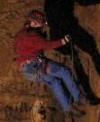I have a Bluewater rack from the late 70's, early eighties with custom stainless steel bars from Bruce at Onrope1. This is the one with the curled eye.
I read in "On Rope" that there was a chance that the eye could come un rolled? Is this possible? would a rescue load( 2 person like in a pick-off) be able to do this?
Any advice would be greatly appreciated.
Paul Siegel
Bluewater rack Question
Moderator: Tim White
10 posts
• Page 1 of 1
Bluewater rack Question
Paul Siegel
NSS#55641
NSS#55641
- PaulSiegel
- Occasional Poster
- Posts: 28
- Joined: Sep 18, 2005 4:13 pm
- Location: College in Tacoma, Washington by way of Atlanta, Ga
I have not seen it happen, but evidently the bending force is low enough that conceivable a rescue load could do it from what I've been taught.
I would not use it for a rescue load.
I would not use it for a rescue load.
-

Stridergdm - NSS Hall Of Fame Poster
- Posts: 931
- Joined: Nov 1, 2005 10:08 am
- Location: Capital District NY and Northern Virginia
- Name: Greg Moore
- Primary Grotto Affiliation: RPI Grotto
I'm not aware of any "trail of dead bodies" from 'normal' use of these curled eye racks. However, the safety margins aren't good (see below). I recall some talk about it being possible to uncurl/deform the eye if you manage to load the rack over an edge - ie the frame of the rack is against the rock acting as a pivot point. However I can't find any specific references to that issue.
You might want to check out Nylon Highway #34 (June 1991), which has an article entitled "A Safety Enhancement of the Curled Eye of the Brake Bar Rappel Rack" on page 21.
http://www.caves.org/section/vertical/nhback/NH34.pdf
The article states that, in testing, these rack eyes can uncurl with as little as 800lbs of force applied - a safety margin of only about 4:1 for a single person load. This should be a concern to anyone using the rack, but especially when it might be used for lowering a rescue load (2 person or more).
The article explores a number of options for modifying the original rack design to make it stronger. It seems the simplest (and preferred) method is to weld around the curls of the eye. Personally I would suggest this option, at least for peace of mind if nothing else.
Hope this helps.
You might want to check out Nylon Highway #34 (June 1991), which has an article entitled "A Safety Enhancement of the Curled Eye of the Brake Bar Rappel Rack" on page 21.
http://www.caves.org/section/vertical/nhback/NH34.pdf
The article states that, in testing, these rack eyes can uncurl with as little as 800lbs of force applied - a safety margin of only about 4:1 for a single person load. This should be a concern to anyone using the rack, but especially when it might be used for lowering a rescue load (2 person or more).
The article explores a number of options for modifying the original rack design to make it stronger. It seems the simplest (and preferred) method is to weld around the curls of the eye. Personally I would suggest this option, at least for peace of mind if nothing else.
Hope this helps.
-

NZcaver - Global Moderator
- Posts: 6367
- Joined: Sep 7, 2005 2:05 am
- Location: Anchorage, Alaska
- Name: Jansen
- NSS #: 50665RL
Thanks for the answer, ill have to explore the back issues of the vertical highway some time..
The only reason I ask is that im taking the NCRC in june/july and wouldn't wont to be caught with my pants down, so to speak..
The only reason I ask is that im taking the NCRC in june/july and wouldn't wont to be caught with my pants down, so to speak..
Paul Siegel
NSS#55641
NSS#55641
- PaulSiegel
- Occasional Poster
- Posts: 28
- Joined: Sep 18, 2005 4:13 pm
- Location: College in Tacoma, Washington by way of Atlanta, Ga
PaulSiegel wrote:Thanks for the answer, ill have to explore the back issues of the vertical highway some time..
The only reason I ask is that im taking the NCRC in june/july and wouldn't wont to be caught with my pants down, so to speak..
You'll be fine there.
It won't be used for any rigging purposes. And for the pick-offs, you can always swap gear if you need to.
Now speaking strictly completely outside any role with the NCRC, in my pure PERSONAL opinion, I would not have a problem using it for a 2 person pick off unless you think the total load is going to exceed 500-600lbs.
The thing is, for a two-person pick-off, the load is going to be fairly static once you descend. Unless you and your patient jump off a ledge, the total load won't exceed the 800lb limit.
Now, for a rigging problem, I would NOT use it. While in theory for a fixed brake load, the load shouldn't change much over time, there's just too many variables where all of a sudden you might find yourself having to catch a force that is 2x or 3x your static load. Bam, you've just exceeded the safety factor of your system.
(when you get to weeklong, look in your packet, there should be an article by Steve Hudson discussing system safety factors. It's a good read.)
(and worse comes to worse, I should have my 2nd frog set with me, you can borrow a microrack for your pickoffs ;-)
-

Stridergdm - NSS Hall Of Fame Poster
- Posts: 931
- Joined: Nov 1, 2005 10:08 am
- Location: Capital District NY and Northern Virginia
- Name: Greg Moore
- Primary Grotto Affiliation: RPI Grotto
I've got one too, and I've used it for rescue loads.
I did this before the warnings every came out.
I too am kinda concerned about the warnings, but that rack is very strong and I just can't see the point of replacing it. The only time I got in trouble with it, the entire thing started to bend, which had nothing to do with the attachment. I've had no trouble with it otherwise.
I really wonder if the warnings are appropriate.
I did this before the warnings every came out.
I too am kinda concerned about the warnings, but that rack is very strong and I just can't see the point of replacing it. The only time I got in trouble with it, the entire thing started to bend, which had nothing to do with the attachment. I've had no trouble with it otherwise.
I really wonder if the warnings are appropriate.
-

George Dasher - NSS Hall Of Fame Poster
- Posts: 693
- Joined: Sep 22, 2005 2:00 pm
- Location: West Virginia
- NSS #: 16643
- Primary Grotto Affiliation: Charleston Grotto
George Dasher wrote:I've got one too, and I've used it for rescue loads.
I did this before the warnings every came out.
I too am kinda concerned about the warnings, but that rack is very strong and I just can't see the point of replacing it. The only time I got in trouble with it, the entire thing started to bend, which had nothing to do with the attachment. I've had no trouble with it otherwise.
I really wonder if the warnings are appropriate.
Appropriate yes.
Something to worry about... maybe, maybe not.
Like any piece of equipment, it's important to know its limitations.
-

Stridergdm - NSS Hall Of Fame Poster
- Posts: 931
- Joined: Nov 1, 2005 10:08 am
- Location: Capital District NY and Northern Virginia
- Name: Greg Moore
- Primary Grotto Affiliation: RPI Grotto
George Dasher wrote:I've got one too, and I've used it for rescue loads.
I did this before the warnings every came out.
I too am kinda concerned about the warnings, but that rack is very strong and I just can't see the point of replacing it. The only time I got in trouble with it, the entire thing started to bend, which had nothing to do with the attachment. I've had no trouble with it otherwise.
I really wonder if the warnings are appropriate.
I would say the warnings are appropriate.
As I mentioned in my previous post, some of these racks have - when formally tested - shown a safety margin of a mere 4:1 for a single person load. Assuming the rest of your system is up-to-scratch, this rack could end up being the "weakest link" (not counting the human factor), and significantly reduce your overall system safety factor. Saying that a rack is "very strong" is all well and good - but what are you basing your conclusion on? The fact that your one hasn't failed yet, or have you actually destruction-tested one of these yourself?
Incidentally, many years ago I was asked to sacrifice my very first rack - a stainless U rack used just a few times - for destruction testing. I agreed, and it broke at around 50kN (11,000lbs) - a saftey margin of 50:1, total overkill. This was a direct pull test, and was not rigged to a rope (which likely would have failed at 30kN or less). But it did prove a point, and I earned a brand new rack for my troubles.
Instead of replacing your nice rack, have you thought about simply having it modified like the article suggests?
-

NZcaver - Global Moderator
- Posts: 6367
- Joined: Sep 7, 2005 2:05 am
- Location: Anchorage, Alaska
- Name: Jansen
- NSS #: 50665RL
I've thought about having the modifications done, but having neither the welding skills nor the welder I'd probably just replace it, either with a rack or a bobbin. I wouldn't feel comfortable with giving that job to anyone, especially considering the need for strength and safety consequences if it does fail.
Isn't there something about gear that you should replace it every 20 years or something? metal fatigue, invisible micro-cracks, etc? Or is that just nylon gear? Most of my vertical experience comes from rock climbing were we retire carabiners and ropes every 5 years to non-Personal Protection use.
Besides:
NEW GEAR!
Isn't there something about gear that you should replace it every 20 years or something? metal fatigue, invisible micro-cracks, etc? Or is that just nylon gear? Most of my vertical experience comes from rock climbing were we retire carabiners and ropes every 5 years to non-Personal Protection use.
Besides:
NEW GEAR!

Paul Siegel
NSS#55641
NSS#55641
- PaulSiegel
- Occasional Poster
- Posts: 28
- Joined: Sep 18, 2005 4:13 pm
- Location: College in Tacoma, Washington by way of Atlanta, Ga
PaulSiegel wrote:Isn't there something about gear that you should replace it every 20 years or something? metal fatigue, invisible micro-cracks, etc?
Stainless steel develops these kind of cracks in the presence of chlorine only. (Fluorine and the other halogens do not do this to stainless steel 303,304,316)It is called chloride stress corrosion, it can look perfect but break easily and without warning. I hope you do not store it in a chlorine gas or chlorine liquid environment...

"People who really believe that global warming leads us to a doomsday should be treated as mentally ill." Quote : Luboš Motl
-

Mark620 - NSS Hall Of Fame Poster
- Posts: 227
- Joined: Sep 14, 2005 6:58 pm
- Location: <1/4 mile from: Secret Cave, Putnam Co., TN
- NSS #: 55638
- Primary Grotto Affiliation: Cave Owners Club _ I own Caves
10 posts
• Page 1 of 1
Who is online
Users browsing this forum: No registered users

